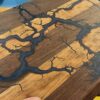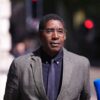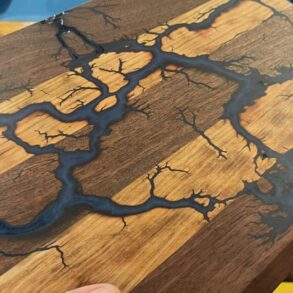Featured Image: Oberon, Titania and Puck with Fairies Dancing, by William Blake
Much like the present moment, the nineteenth century was a time of rapid social and technological change and political turmoil. In England, the first railroads began crossing the country in 1830, which opened the floodgates to individual mobility and mass industrialization. The revolutions of 1848 that swept across Europe challenged absolute monarchies and capitalism; protesters demanded everything from freedom of the press to women’s suffrage, workers’ rights and political reform.
In 1859, the publication of Charles Darwin’s On the Origin of Species questioned long-held beliefs in divine creation; the discovery of electromagnetic waves in 1886, the invention of the X-ray in 1895—what was invisible could now be seen—and radioactivity in 1896 proved that the physical world was as mutable as alchemists had always believed. A flurry of artistic movements came into being, testing the limits of art’s perceptual relationship to the spiritual and physical realms.
Romanticism—full of moody lakes and brooding mountains, with men gazing into infinity and women embodying everything from virtue to sin—valorized subjectivity over eighteenth-century rationalism and paved the way for Surrealism, with its embracing of unreason and journeys into the recesses of the mind.
In Paris’s belle époque, Symbolism offered an escape from the hardships of everyday life via waking dreams and mysticism. Inspired by movements such as Rosicrucianism—the seventeenth-century Brotherhood of the Rosy Cross—a dizzying amount of Spiritualist groups gained a foothold in the imaginations of artists and writers.
Two of them in particular were to have an impact on modern art: Theosophy, and London’s Hermetic Order of the Golden Dawn, a late nineteenth-century secret, ceremonial magic order devoted to the study of the occult, metaphysics and the paranormal.
In the mid-1990s, I was granted a fellowship from my art school in Melbourne to travel to London to paint. A few months after I arrived, I visited the Royal Academy to see an exhibition of work by the so-called Young British Artists—Damien Hirst, Sarah Lucas and others. I was in a conundrum: I felt I had to return to Australia, but I wanted to stay in London. I was looking for something but what it was, I couldn’t say.
I knew it wasn’t the work of the Young British Artists; much of it sizzled with life but was too big and brash for my state of mind; it was like being shouted at in a pub. (It reminded me of the Melbourne art movement in the 1980s, which was called “Roar.” My friend David and I decided to start a counter-movement called “Whimper.”) I was worrying about the pictures I was making; the money was running out and I had just begun waitressing in a Soho café called Aurora. (The irony of its celestial name in a city where light pollution had made all but the brightest stars disappear didn’t escape me.) Feeling rather dejected, on my way out of the Royal Academy my attention was caught by a sign advertising a side exhibition of Victorian fairy painting.
I entered and felt an immediate kinship: sixty-six hallucinatory paintings and drawings from the golden age of fairy painting, which took place between about 1840 and 1870—something I knew absolutely nothing about. I was entranced by the near-supernatural powers of observation of Richard Dadd, the wild fancies, translucent beings and benign animals who populated John Anster “Fairy” Fitzgerald’s canvases and the thinly veiled orgies—which masqueraded as meetings of fairy courts—of Noel Paton and Robert Huskisson.
Out of the thirty-five artists included in the show, only two were women: the pre-Raphaelite painter, illustrator and women’s rights campaigner Eleanor Fortescue-Brickdale, and the Italian-British artist, writer, illustrator and folklorist Estella Canziani. The strange worlds these artists evoked, so teeming with life, chimed with my sense of dislocation. In one fell swoop my inarticulate longing for something that might elevate a waitress’s daily grind was assuaged.
Whereas the words “fairy painting” now imply something saccharine, in the nineteenth century it was a serious business—a convenient loophole in the skewed logic of Victorian censoriousness. Unlike contemporary fairies, who have been relegated to the nursery, their Victorian audience was an adult one and painters competed to come up with visions that were ever more extreme.
If a painter put wings on an image of a naked girl, then she was no longer human, and so exempt from the rules of propriety that governed representations of the so-called real world—she could fly half-naked, if the painter so desired. Yet despite the wild scenarios, these artists weren’t plucking their visions from the air. The many motivations for wanting to believe in other realms have, over the centuries, been manifold. British culture, like all cultures, is rich with occult references.
Many of the esoteric beliefs that were to become so popular in the nineteenth and twentieth centuries grew from myths, which, as the embodiment of the cumulative experience of generations of country-dwellers, changed with each telling. Shakespeare, in particular, made use of folklore, especially in A Midsummer Night’s Dream and The Tempest, plays which understood that life is fleeting, dreams can guide us and the physical realm is often illusory. Fairies were slippery signifiers: stars of the stage, symbolic remnants of a displaced people, fallen angels, heathen dead, the embodiment of a pure soul or the unconscious made flesh.
Shakespeare was just one of the many sources of inspiration for Victorian painters: the fourteenth-century poet and author Geoffrey Chaucer, whose “elf-queene” features in The Canterbury Tales, and William Blake, along with Celtic myths and folk tales, were often referenced. Charles Dickens argued with George Cruickshank—who, in 1823, was the first British illustrator of the Tales of the Brothers Grimm—about the latter’s tendency to use fairy tales as a way of lecturing on the evils of drink.
Dickens believed that fairy tales instilled in children “forbearance, courtesy, consideration for poor and aged, kind treatment of animals, love of nature, abhorrence of tyranny and brute force,” and that “in a utilitarian age, of all other times, it is a matter of grave importance that fairy tales should be respected … A nation without fancy, without some great romance, never did, never can, never will hold a place under the sun.”
Whereas the words “fairy painting” now imply something saccharine, in the nineteenth century it was a serious business—a convenient loophole in the skewed logic of Victorian censoriousness.
Two decades later, Hans Christian Andersen’s Fairy Tales arrived in England and became a bestseller, translated from the Danish by the poet and activist Mary Howitt, whose husband, the writer William, and daughter, the author and artist Anna Mary (more on her later), were Spiritualists (Mary later converted to Catholicism); the first séance they attended was at the home of the logician and mathematician Augustus de Morgan.
In 1862, “Goblin Market,” Christina Rossetti’s best-known poem—a sinister story of two young sisters lured by goblins into eating forbidden fruit and so losing their innocence—was published, and in 1863, Charles Kingsley’s book The Water Babies: A Fairy Tale for a Land Baby—a tale of a chimney sweep escaping his grim life via drowning and becoming a “water-baby” in a fairy realm—was a hit. In 1865, Lewis Carroll wrote Alice in Wonderland—which he originally titled Alice in Elfland—imagining a dreamworld more vivid than reality.
This constant shift—from oral folk tales to literary fairy tales to poems and pictures, from culture to culture, language to language—was symptomatic of a wider restlessness, or perhaps unease, at the speed of cultural change. As the country became industrialized, the old ways were deemed increasingly anachronistic. But still, the fairies persisted. They were, it would seem, adaptable.
That so many Victorian fairy paintings verge on the hallucinogenic wasn’t simply a response to folklore, urban malaise or swift social change; many artists were imbibing vast amounts of laudanum, the opiate derivative used by painters (and Queen Victoria, who was believed to have attended a séance at her home on the Isle of Wight), to stimulate their imaginations to even higher levels of invention.
I read somewhere that fairy painters guarded their visions so closely that they would cross the road if they saw another painter coming. That said, some artists, such as Richard Dadd, had no need of drugs to induce their revelations: in 1842, on a grand tour of Europe and the Middle East, he became a devotee of Osiris, the Egyptian god of the dead and the afterlife. When he returned to England the following year, Dadd murdered his father at the deity’s behest and spent the rest of his life in a lunatic asylum creating extraordinarily detailed paintings of the creatures who populated his dreams.
I became so obsessed with his pictures—their robust delicacy and wild, imaginative flights, their microscopic flourishes—that I decided to stop painting for a while and write a novel about the year in Richard Dadd’s life when everything went so tragically wrong.
____________________________
Excerpted from The Other Side: A Story of Women in Art and the Spirit World by Jennifer Higgie. Copyright © 2024. Published by Pegasus Books.
This post was originally published on this site be sure to check out more of their content








